Analysing the Effects of Forest Cover and Irrigation Farm Dams on Streamflows of Water-Scarce Catchments in South Australia through the SWAT Model
Abstract
:1. Introduction
2. Materials and Methods
2.1. Study Area
2.2. SWAT Model Input Data
2.3. SWAT Model Set-Up
2.4. Farm Dams Configuration
2.5. Estimation of Irrigation Inputs
2.6. Model Evaluation
2.7. Scenario Analysis
3. Results and Discussion
3.1. Parameter Sensitivity Analysis
3.2. Model Calibration and Validation
3.3. Effect of Forest Land Use Change
3.4. Effect of Irrigation Farm Dams
4. Conclusions
- The auto-calibration using NS as an objective function performed satisfactorily for catchments dominated by low flows (0.1 m3/s). Calibration statistics and uncertainty values met the criteria better when irrigation practices were properly characterized, both spatially and temporally, in the model.
- The daily calibration improved significantly when the BFS method embedded in the NS analysis was applied for catchments dominated by zero flow.
- The projected extension of forest cover leads to a decrease in the simulated surface flow and water yield and an increase in the simulated ET and base-flow, while additional proportion of pasture caused the contrary pattern in water balance components.
- A scenario analysis indicated that the purpose of farm dams determined their effect on streamflows rather than the number of farm dams. Catchments with intensive irrigation by orchards and vineyards experienced more severe declines in streamflow during irrigation intensive seasons than catchments dominated by pastures.
- With water resources in the study area having recently been “prescribed” and extraction allocations being set, as well as extraction restrictions being applied during drought periods, modelling during the study time period suggested that effects of water extraction from farm dams had not significantly threatened natural streamflow conditions during those times. The model highlighted the importance of considering the effects of irrigation on the hydrology conditions of water limited catchments. The outputs from this study suggested a necessity to further investigate the effects of farm dams on the catchment hydrological dynamics apart from their roles solely as irrigation sources for the adaptive management of catchments.
Acknowledgments
Author Contributions
Conflicts of Interest
References
- Van Otrop, F.F.; Vervoort, R.W.; Heller, G.Z.; Stasinopoulos, D.M.; Rigby, R.A. Long-range forecasting of intermittent streamflow. Hydrol. Earth Syst. Sci. 2011, 15, 3343–3354. [Google Scholar] [CrossRef] [Green Version]
- Saha, P.P.; Zeleke, K. Rainfall-Runoff Modelling for Sustainable Water Resources Management: SWAT Model Review in Australia. In Sustainability of Integrated Water Resources Management. Water Governance, Climate and Ecohydrology (eBook); Setegn, S.G., Donoso, M.C., Eds.; Springer International Publishing AG: Cham, Switzerland, 2015; pp. 563–578. [Google Scholar]
- Majumdar, D.K. Irrigation Water Management: Principle and Practice, 2nd ed.; Prentice-Hall of India: Delhi, India, 2013; p. 572. [Google Scholar]
- Brown, S.C.; Versace, V.L.; Lester, R.E.; Walter, M.T. Assessing the impact of drought and forestry on stream flows in south-eastern Australia using a physically based hydrological model. Environ. Earth Sci. 2015, 74, 6047–6063. [Google Scholar] [CrossRef]
- Australian Bureau of Statistics (ABS). Available online: http://www.abs.gov.au/AUSSTATS/[email protected]/second+level+view?ReadForm&prodno=4618.0&viewtitle=Water%20Use%20on%20Australian%20Farms~2007-08~Previous~26/05/2009&&tabname=Past%20Future%20Issues&prodno=4618.0&issue=2007-08&num=&view=& (accessed on 1 October 2015).
- Shrestha, M.K.; Recknagel, F.; Frizenschaf, J.; Meyer, W. Assessing SWAT models on single and multi-site calibration for the simulation of flow and nutrients loads in the semi-arid Onkaparinga catchment in South Australia. Agric. Water Manag. 2016, 175, 61–71. [Google Scholar] [CrossRef]
- Ilman, M.A.; Gell, P.A. Sediments, Hydrology and Water Quality of the River Torrens: A Modern and Historical Perspectives: Three Projects for the River Torrens Water Catchment Management Board; Department of Geographical and Environmental Studies, University of Adelaide: Adelaide, Australia, 1998; pp. 10–53. [Google Scholar]
- Smakhtin, V.U. Low Flow Hydrology: A Review. J. Hydrol. 2001, 240, 147–186. [Google Scholar] [CrossRef]
- Rebbeck, M.; Dwyer, E.; Bartetzko, M.; Williams, A. A Guide to Climate Change and Adaptation in Agriculture in South Australia; South Australian Research and Development Institute, Primary Industries and Resources SA and Rural Solutions SA: Urrbrae, Australia, 2007; pp. 12–22. [Google Scholar]
- Hawthorne, K. A Methodology for Estimating Regional Agricultural Water Use; Research Paper 4616.0.55.001; Australia Bureau of Statistics: Belconne, Australia, 2006. Available online: http://www.ausstats.abs.gov.au/ausstats/subscriber.nsf/0/0186AA6011A98B42CA2571EE001EE96E/$File/4616055001_sep%202006.pdf (accessed on 6 January 2017).
- Heneker, T.M. Surface Water Assessment of the Upper River Torrens Catchment; Report DWLBC 2003/2004; The Department of Water, Land and Biodiversity Conservation: Adelaide, Autralia, 2003; pp. 35–105.
- Tingey-Holyoak, J.L. Water sharing risk in agriculture: Perceptions of farm dam management accountability in Australia. Agric. Water Manag. 2014, 145, 123–133. [Google Scholar] [CrossRef]
- Pushpalatha, R.; Perrin, C.; Moine, N.L.; Andreassian, V. A review of efficiency criteria suitable for evaluating low-flow simulations. J. Hydrol. 2011, 420–421, 171–182. [Google Scholar] [CrossRef]
- Demirel, M.C.; Booij, M.J.; Hoekstra, A.Y. The skill of seasonal ensemble low-flow forecasts in the Moselle River for three different hydrological models. Hydrol. Earth Syst. Sci. 2015, 19, 275–291. [Google Scholar] [CrossRef]
- Alcorn, M.R. Hydrological Modelling of the Eastern Mount Lofty Ranges: Demand and Low Flow Bypass Scenarios; Department for Water: Adelaide, Australia, 2011; pp. 2–42. ISBN 978-1-921923-02-9. [Google Scholar]
- Fleming, N.K.; Cox, J.W.; He, Y.; Thomas, S. Source Catchment Hydrological Calibration in the Mount Lofty Ranges Using PEST Parameter Optimisation Tool; eWater CRC: Canberra, Autralia, 2012; pp. 10–21. ISBN 978-1-921543-63-0. [Google Scholar]
- Alcorn, M.R. Hydrological Model of the Onkaparinga Catchment, South Australia: Calibration Report; DEWNR Technical Report 2015/02; Department of Environment, Water and Natural Resources: Adelaide, Australia, 2015; pp. 2–24. ISBN 978-1-922255-29-7. [Google Scholar]
- Marston, F.; Argent, R.; Vertessy, R.; Cuddy, S.; Rahman, J. The Status of Catchment Modelling in Australia. Cooperative Research Centre for Catchment Hydrology; Technical Report 02/04; Monash University: Melbourne, Australia, 2002. [Google Scholar]
- Arnold, J.G.; Srinivasan, R.; Muttiah, R.S.; Williams, J.R. Large area hydrologic modelling and assessment part I: Model development. J. Am. Water Resour. Assoc. 1998, 34, 73–89. [Google Scholar] [CrossRef]
- Gassman, P.W.; Reyes, M.R.; Green, C.H.; Arnold, J.G. The Soil and Water Assessment Tool: Historical development, applications and future research directions. Trans. ASAE (Am. Soc. Agric. Eng.) 2007, 50, 1211–1250. [Google Scholar] [CrossRef]
- Moriasi, D.N.; Arnold, J.; Van Liew, M.; Bingner, R.L.; Harmel, R.D.; Veith, T.L. Model evaluation guidelines for systematic quantification of accuracy in watershed simulations. Trans. ASAE (Am. Soc. Agric. Eng.) 2007, 50, 885–900. [Google Scholar]
- Arnold, J.G.; Moriasi, D.N.; Gassman, P.W.; Abbaspour, K.C.; White, M.J.; Srinivasan, R.; Santhi, C.; Harmel, R.D.; van Griensven, A.; Van Liew, M.W.; et al. SWAT: Model use, calibration, validation. Trans. ASABE (Am. Soc. Agric. Eng.) 2012, 55, 1491–1508. [Google Scholar]
- Abbaspour, K.C.; Rouholahnejad, E.; Vaghefi, S.; Srinivasan, R.; Yang, H.; Klove, B. A continental-scale hydrology and water quality model for Europe: Calibration and uncertainty of a high-resolution large scale SWAT model. J. Hydrol. 2015, 524, 733–752. [Google Scholar] [CrossRef]
- Saha, P.P.; Zeleke, K.; Hafeez, M. Streamflow modelling in a fluctuant climate using SWAT: Yass River catchment in south eastern Australia. Environ. Earth Sci. 2014, 71, 5241–5254. [Google Scholar] [CrossRef]
- Schuol, J.; Abbaspour, K.C.; Yang, H.; Srinivasan, R.; Zhender, A.J.B. Modeling blue and green water availability in Africa. Water Resour. Res. 2015, 44, 1–18. [Google Scholar] [CrossRef]
- Pfannerstill, M.; Björn, G.; Fohrer, N. Smart Low Flow Signature Metrics for an Improved Overall Performance Evaluation of Hydrological Models. J. Hydrol. 2014, 510, 447–458. [Google Scholar] [CrossRef]
- Krause, P.; Boyle, D.P.; Bäse, F. Comparison of different efficiency criteria for hydrological model assessment. Adv. Geosci. 2005, 5, 89–97. [Google Scholar] [CrossRef]
- Muleta, M.K. Improving Model Performance Using Season-based Evaluation. J. Hydrol. Eng. 2012, 17, 191–200. [Google Scholar] [CrossRef]
- Kim, H.S.; Lee, S. Assessment of a seasonal calibration technique using multiple objectives in rainfall-runoff analysis. Hydrol. Process. 2014, 28, 2159–2173. [Google Scholar] [CrossRef]
- Zang, D.; Chen, X.; Yao, H.; Lin, B. Improved calibration scheme of SWAT by separating wet and dry seasons. Ecol. Model. 2015, 301, 54–61. [Google Scholar] [CrossRef]
- Brindal, M.; Stringer, R. Water Scarcity and Urban Forests: Science and Public Policy Lessons from a Decade of Drought in Adelaide, Australia. Arboric. Urban For. 2013, 39, 102–108. [Google Scholar]
- Bureau of Meteorology (BOM). Available online: http://www.bom.gov.au/climate/updates/articles/a010-southern-rainfall-decline.shtml (accessed on 2 January 2016).
- Australian Soil Resource Information System (ASRIS). Available online: http://www.asris.csiro.au/mapping/viewer.htm (accessed on 1 March 2015).
- Scientific Information for Land Owners (SILO). Available online: http://www.longpaddock.qld.gov.au/silo/ppd/index.php (accessed on 1 February 2015).
- Winchell, M.; Srinivasan, R.; Di Luzio, M.; Arnold, J. Arc SWAT Interface for SWAT2012 User’s Guide; Texas AgriLife Research and United States Department of Agriculture: Temple, TX, USA, 2013.
- Neitsch, S.L.; Arnold, J.G.; Kinir, J.R.; Wiliams, J.R. Soil and Water Assessment Tool: Theoretical Documentation 2009; Technical Report No. 406; Texas Water Resources Institute-Texas A&M University: College Station, TX, USA, 2011; pp. 29–180. [Google Scholar]
- Soil Conservation Service (SCS). Section 4-Hydrology. In SCS National Engineering Handbook; USDA: Washington, DC, USA, 1972. [Google Scholar]
- Hargreaves, G.H.; Samani, Z.A. Reference crop evapotranspiration from temperature. Appl. Eng. Agric. 1985, 1, 96–99. [Google Scholar] [CrossRef]
- Arnold, J.G.; Kiniry, J.R.; Srinivasan, R.; Wiliams, J.R.; Haney, E.B.; Neitsch, S.L. Soil and Water Assessment Tool: Input/Output Documentation; Technical Report; Texas Water Resources, Institute-Texas A&M University: College Station, TX, USA, 2012; Volume 439, pp. 2–620. [Google Scholar]
- Data.SA (South Australian Government Data Directory). Available online: http://data.sa.gov.au/data/dataset/cc790713-4cf0-4bd4-bca8-f195d8e202b7 (accessed on 1 November 2015).
- Abbaspour, K.C. SWAT-CUP: SWAT Calibration and Uncertainty Programs—A User Manual; Eawag: Dübendorf, Switzerland, 2015; pp. 16–70. [Google Scholar]
- Abbaspour, K.C.; Yang, J.; Maximov, I.; Siber, R.; Boger, K.; Mieletner, J.; Zobrist, J.; Srinivasan, R. Modelling hydrology and water quality in the pre-alpine/alpine Thur watershed using SWAT. J. Hydrol. 2007, 333, 413–430. [Google Scholar] [CrossRef]
- Githui, F.; Thayalakumaran, T.; Selle, B. Estimating irrigation inputs for distributed hydrological modelling: A case study from an irrigated catchment in southeast Australia. Hydrol. Process. 2015, 30, 1824–1835. [Google Scholar] [CrossRef]
- Tuppad, P.; Douglas-Mankin, K.R.; Lee, T.; Srinivasan, R.; Arnold, J.G. Soil and Water Assessment Tool (SWAT) hydrologic/water quality model: Extended capability and wider adoption. Trans. ASABE 2011, 54, 1677–1684. [Google Scholar] [CrossRef]
- Hulme, K.A. Eucalyptus Camaldulensis (River Red Gum). Biogeochemistry: An Innovative Tool for Mineral Exploration in the Curnamona Province and Adjacent Regions. Ph.D. Thesis, School of Earth and Environmental Sciences, University of Adelaide, Adelaide, Australia, 2008. [Google Scholar]
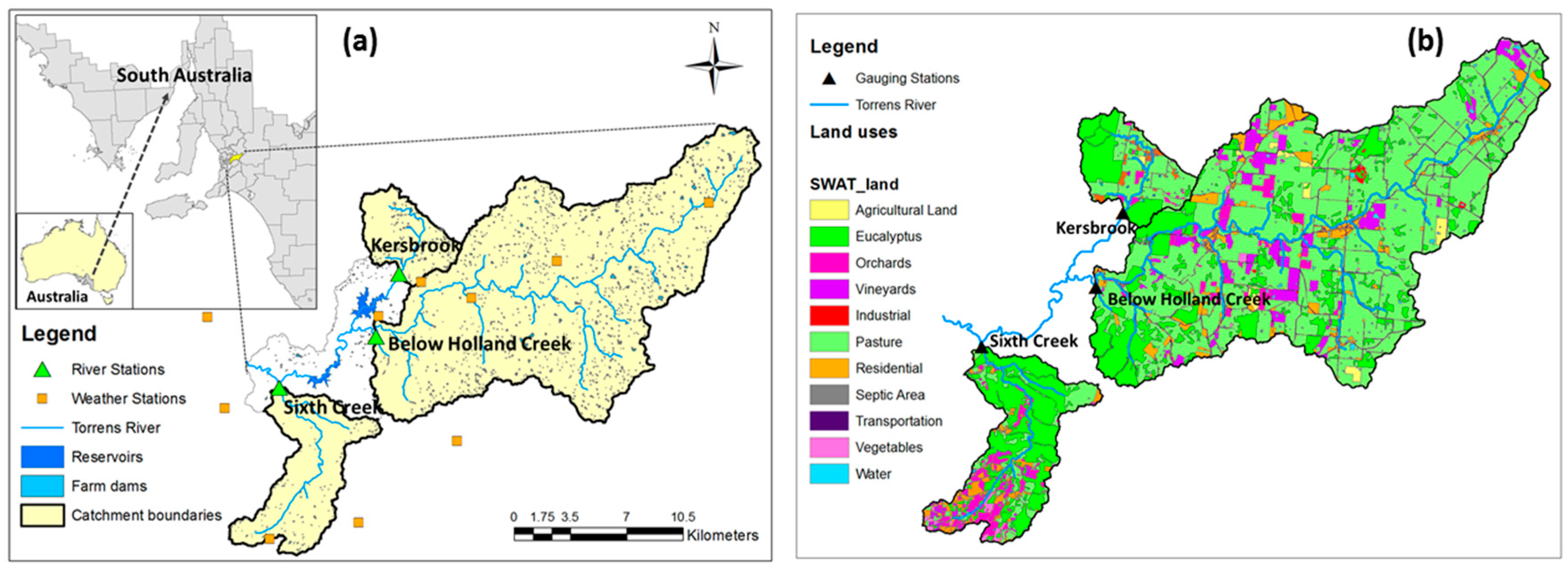
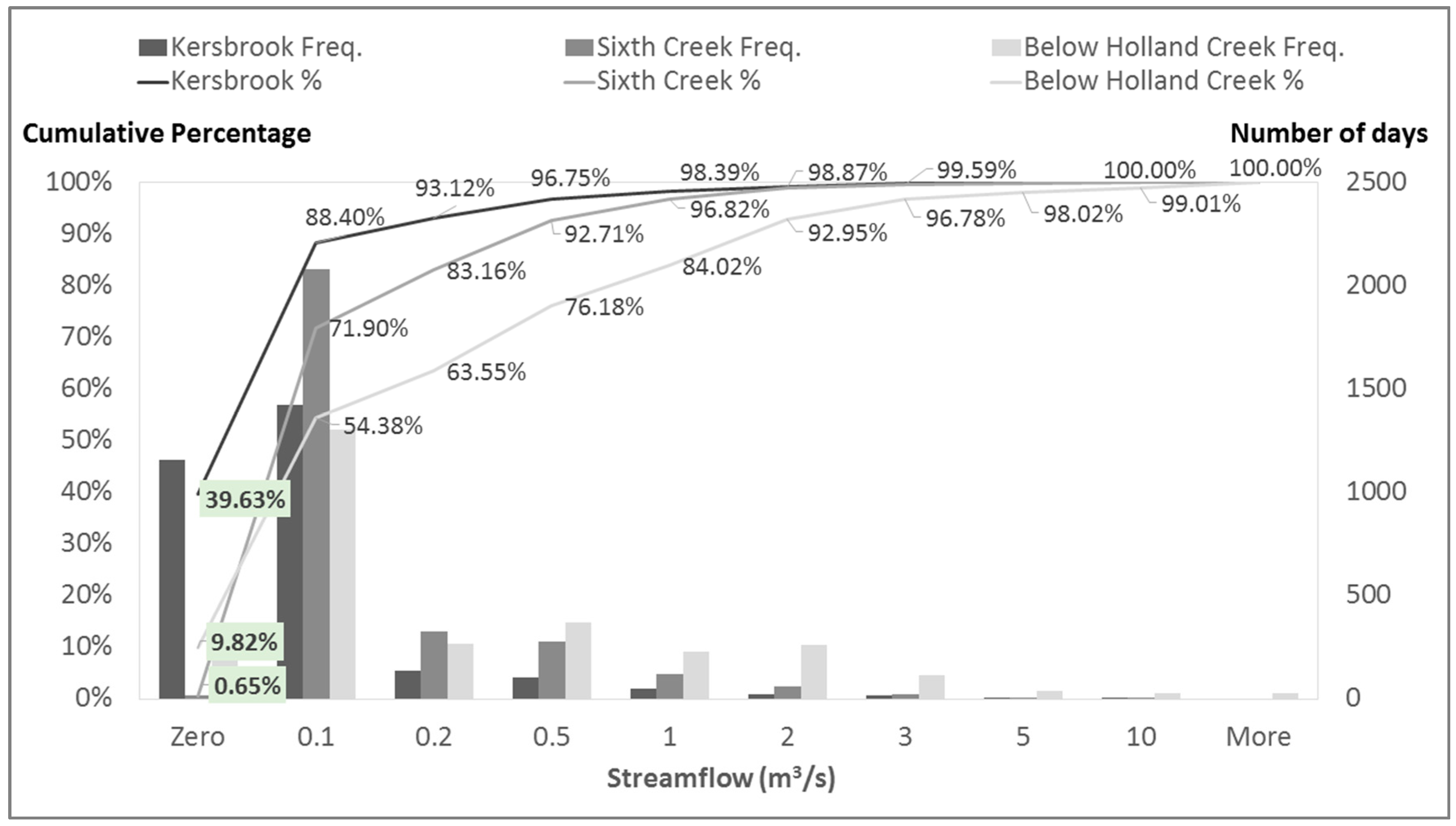
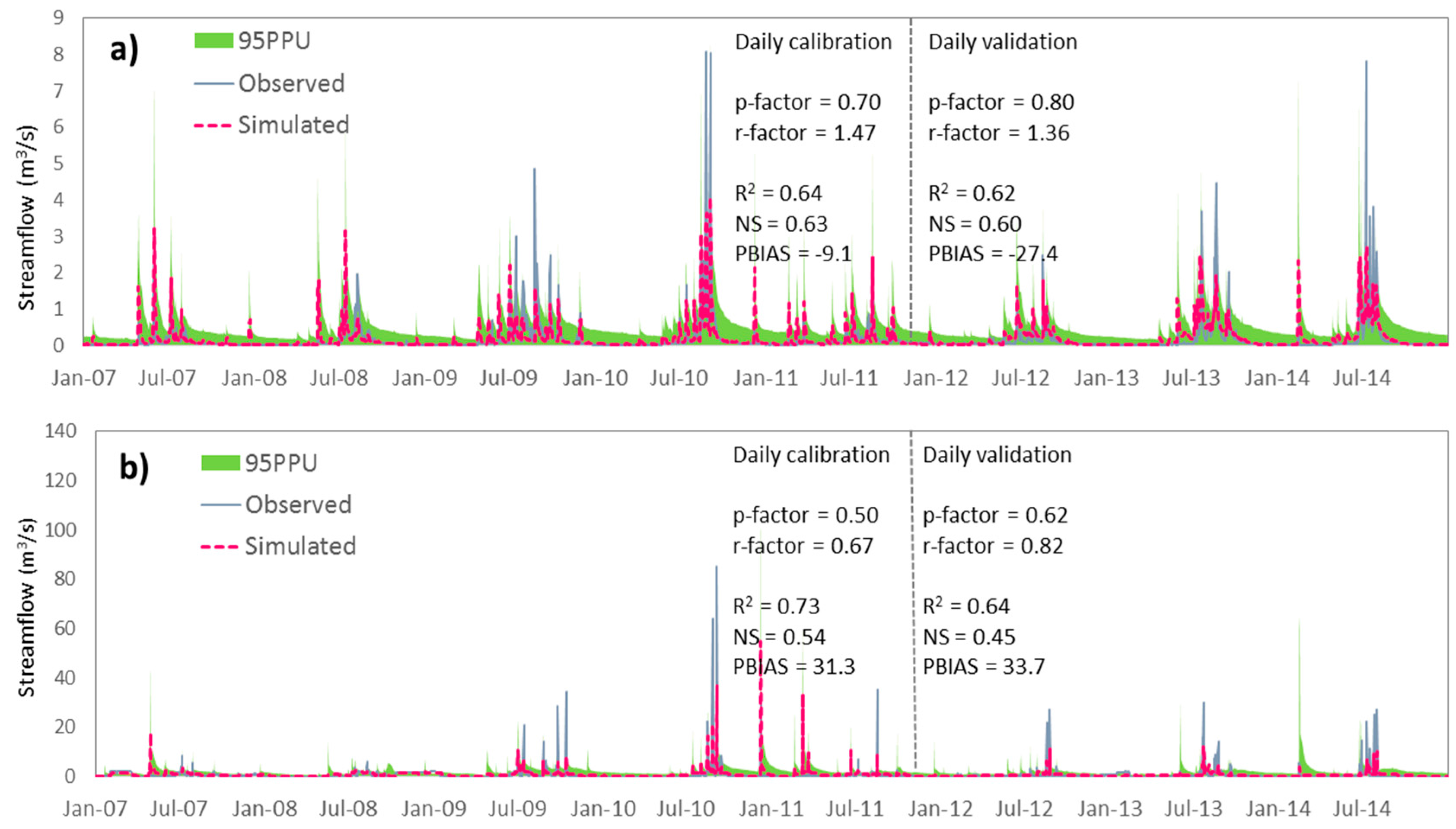
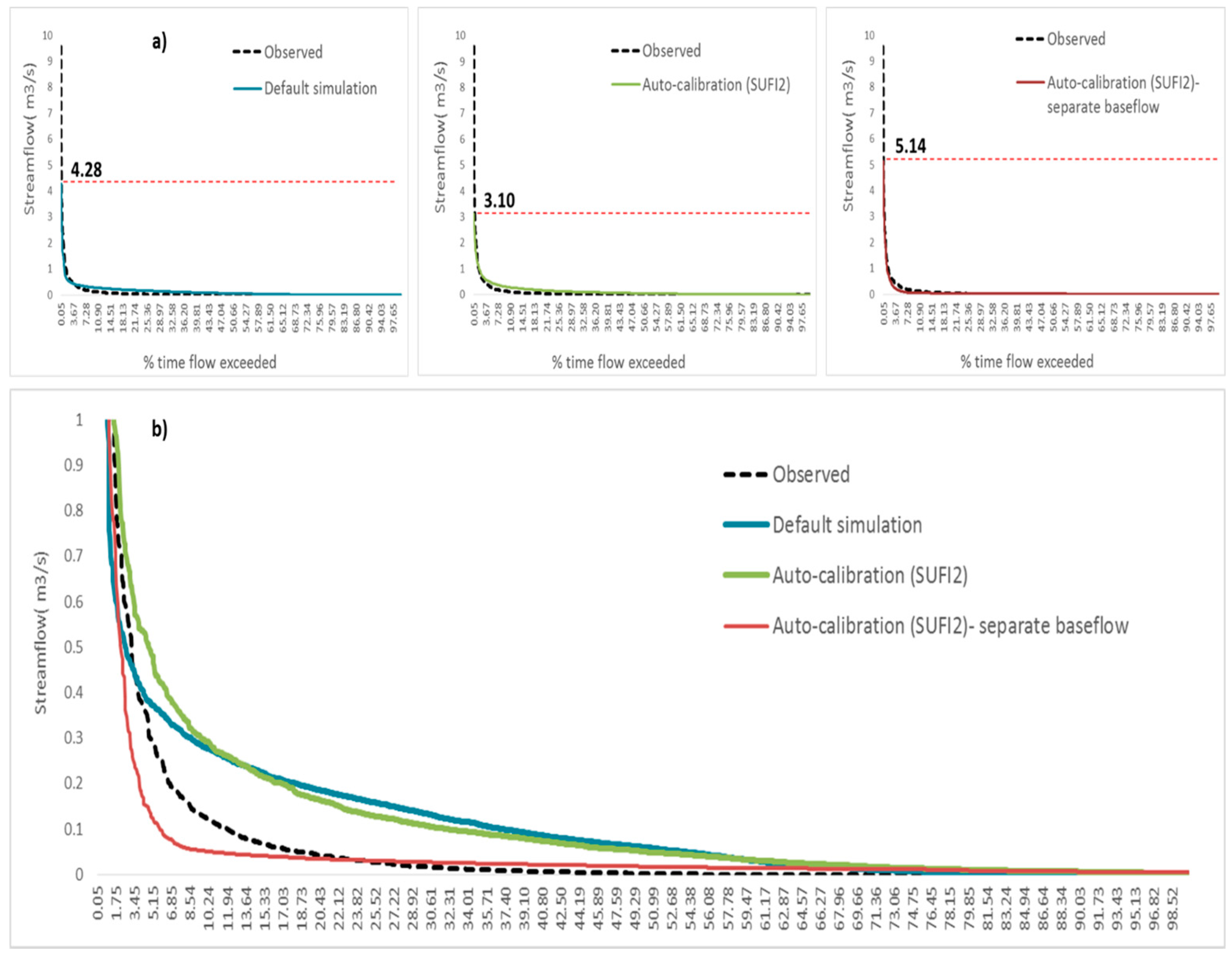
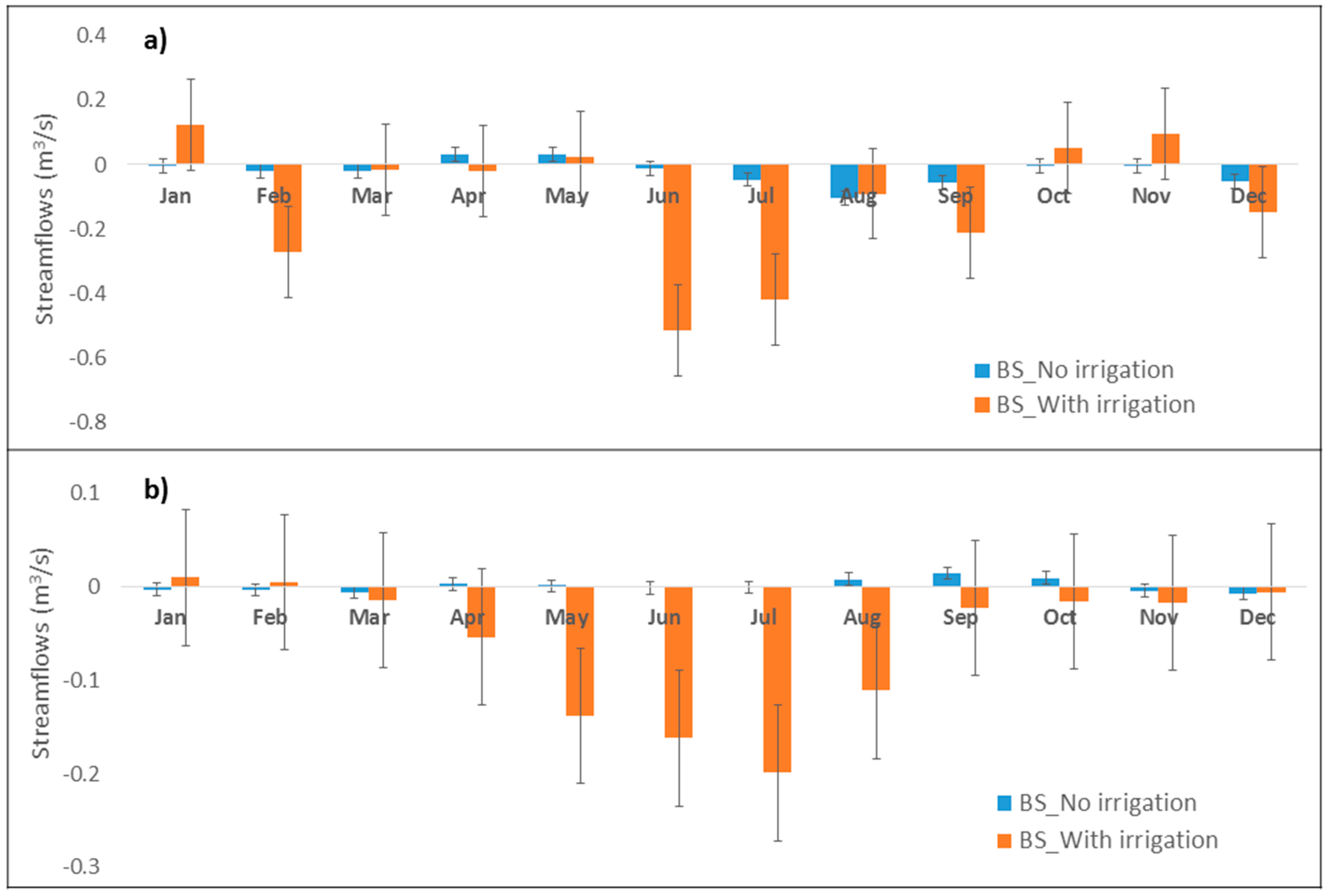
| Model Parameters | Abbreviation | Units | Initial Values | Modelled Values | ||||
|---|---|---|---|---|---|---|---|---|
| Min | Max | Default | Min | Max | Mean | |||
| PND_FR | Fraction of sub-basin area that drains into ponds | fraction | 0.00 | 1 | 0.00 | 0.00 | 1.00 | 0.40 |
| PND_PSA | Surface area of ponds when filled to principal spillway | ha | 0.10 | 20 | 5 | 0.00 | 30.24 | 7.55 |
| PND_PVOL | Volume of water needed to fill ponds to the principal spillway | 104 m3 | 0.00 | 100 | 25 | 0.00 | 47.04 | 12.14 |
| PND_VOL | Initial volume of water in ponds | 104 m3 | 0.00 | 100 | 0 | 0.00 | 4.70 | 1.21 |
| NDTARG | Number of days to reach target storage | days | 0 | 60 | 0 | 15 | 15 | 15 |
| Optimization | p-Factor | r-Factor | R2 | PBIAS | Objective Function (NS) | ||
|---|---|---|---|---|---|---|---|
| Final Goal | Best Partial Goal | No. of Behavioral Simulations | |||||
| Calibration | |||||||
| Default simulation | 0.04 | 0 | 0.18 | −274.5 | −0.81 | - | - |
| Auto-calibration (SUFI2) | 0.25 | 0.5 | 0.4 | −65.8 | 0.38 | 0.38 | 0/500 |
| Auto-calibration (SUFI2) with separate base-flow | 0.37 | 0.49 | 0.55 | 19.1 | 0.54 | 0.88 | 500/500 |
| Validation | |||||||
| Default simulation | 0 | 0 | 0.32 | −262.4 | −1.07 | - | - |
| Auto-calibration (SUFI2) | 0.17 | 0.65 | 0.43 | −59.1 | 0.4 | 0.4 | 0/500 |
| Auto-calibration (SUFI2) with separate base-flow | 0.3 | 0.62 | 0.53 | −3.6 | 0.48 | 0.91 | 500/500 |
| Catchment | Area (ha) | Mean Annual Basin Values | ||||
|---|---|---|---|---|---|---|
| Rainfall (mm) | PET (mm) | ET (mm) | Water Yield (mm) | Baseflow/Total Flow (%) | ||
| Below Holland Creek | 19,067.71 | 718 | 1261.94 | 478.21 | 144.86 | 31.00 |
| Kersbrook | 2238.14 | 692 | 1310.01 | 615.35 | 88.38 | 7.00 |
| Sixth Creek | 4301.49 | 896 | 1165.16 | 597.33 | 222.44 | 77.00 |
| Scenario | Forest Cover (%) | Relative Change (%) | ||||
|---|---|---|---|---|---|---|
| Surface Flow | Lateral Flow | Baseflow/Total Flow | Water Yield | ET | ||
| Below Holland Creek | ||||||
| BS | 19.02 | - | - | - | - | - |
| BS Forest +10% | 25.11 | −2.16 | 0.39 | 1.00 | −1.00 | 1.03 |
| BS Forest +50% | 49.48 | −10.93 | 1.80 | 3.00 | −3.61 | 5.12 |
| Kersbrook | ||||||
| BS | 43.55 | - | - | - | - | - |
| BS Forest −10% | 40.24 | 0.54 | −0.36 | 0.00 | 5.30 | −0.06 |
| BS Forest −50% | 27.20 | 2.73 | −1.82 | −1.00 | 6.95 | −0.29 |
| Sixth Creek | ||||||
| BS | 57.04 | - | - | - | - | - |
| BS Forest −10% | 48.65 | 1.91 | −0.12 | 0.00 | 0.98 | −0.47 |
| BS Forest −50% | 27.03 | 9.70 | −0.57 | −1.30 | 4.97 | −2.37 |
| Kersbrook | Sixth Creek | Below Holland Creek | |
|---|---|---|---|
| Mann-Whitney (U-Test) | |||
| p-value | 0.61 | 1.03 × 10−4 | <2.2 × 10−16 |
| Sensitivity | No | Yes | Yes |
| Catchment characteristics | |||
| Farm dams area (km2) | 0.39 (1.74%) a | 0.17 (0.39%) a | 2.90 (1.29%) a |
| Horticulture-viticulture area (km2) | 0.75 (3%) a | 7.13 (17%) a | 17.69 (8%) a |
| - Orchards | 0.72 | 5.06 | 3.86 |
| - Vegetables | - | 0.97 | 0.45 |
| - Vineyards | 0.03 | 1.10 | 13.39 |
© 2017 by the authors; licensee MDPI, Basel, Switzerland. This article is an open access article distributed under the terms and conditions of the Creative Commons Attribution (CC-BY) license (http://creativecommons.org/licenses/by/4.0/).
Share and Cite
Nguyen, H.H.; Recknagel, F.; Meyer, W.; Frizenschaf, J. Analysing the Effects of Forest Cover and Irrigation Farm Dams on Streamflows of Water-Scarce Catchments in South Australia through the SWAT Model. Water 2017, 9, 33. https://doi.org/10.3390/w9010033
Nguyen HH, Recknagel F, Meyer W, Frizenschaf J. Analysing the Effects of Forest Cover and Irrigation Farm Dams on Streamflows of Water-Scarce Catchments in South Australia through the SWAT Model. Water. 2017; 9(1):33. https://doi.org/10.3390/w9010033
Chicago/Turabian StyleNguyen, Hong Hanh, Friedrich Recknagel, Wayne Meyer, and Jacqueline Frizenschaf. 2017. "Analysing the Effects of Forest Cover and Irrigation Farm Dams on Streamflows of Water-Scarce Catchments in South Australia through the SWAT Model" Water 9, no. 1: 33. https://doi.org/10.3390/w9010033






